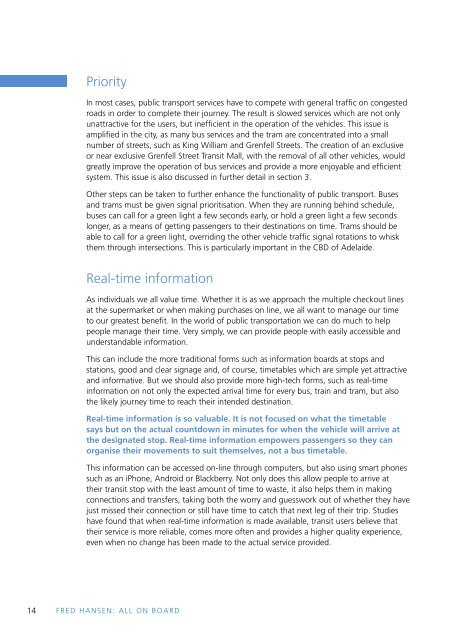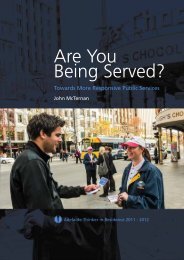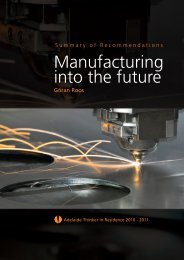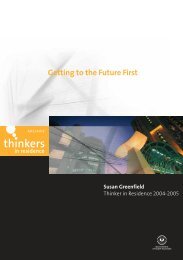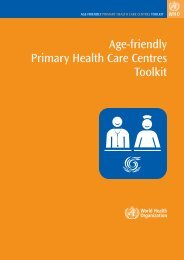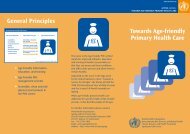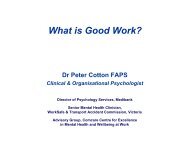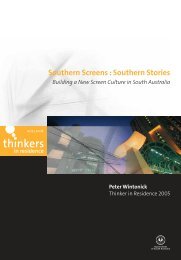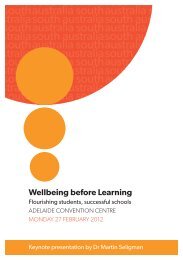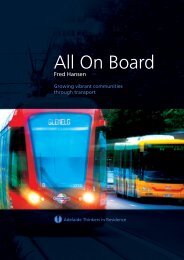Download pdf of Fred Hansen's report - Adelaide Thinkers in ...
Download pdf of Fred Hansen's report - Adelaide Thinkers in ...
Download pdf of Fred Hansen's report - Adelaide Thinkers in ...
- No tags were found...
Create successful ePaper yourself
Turn your PDF publications into a flip-book with our unique Google optimized e-Paper software.
PriorityIn most cases, public transport services have to compete with general traffic on congestedroads <strong>in</strong> order to complete their journey. The result is slowed services which are not onlyunattractive for the users, but <strong>in</strong>efficient <strong>in</strong> the operation <strong>of</strong> the vehicles. This issue isamplified <strong>in</strong> the city, as many bus services and the tram are concentrated <strong>in</strong>to a smallnumber <strong>of</strong> streets, such as K<strong>in</strong>g William and Grenfell Streets. The creation <strong>of</strong> an exclusiveor near exclusive Grenfell Street Transit Mall, with the removal <strong>of</strong> all other vehicles, wouldgreatly improve the operation <strong>of</strong> bus services and provide a more enjoyable and efficientsystem. This issue is also discussed <strong>in</strong> further detail <strong>in</strong> section 3.Other steps can be taken to further enhance the functionality <strong>of</strong> public transport. Busesand trams must be given signal prioritisation. When they are runn<strong>in</strong>g beh<strong>in</strong>d schedule,buses can call for a green light a few seconds early, or hold a green light a few secondslonger, as a means <strong>of</strong> gett<strong>in</strong>g passengers to their dest<strong>in</strong>ations on time. Trams should beable to call for a green light, overrid<strong>in</strong>g the other vehicle traffic signal rotations to whiskthem through <strong>in</strong>tersections. This is particularly important <strong>in</strong> the CBD <strong>of</strong> <strong>Adelaide</strong>.Real-time <strong>in</strong>formationAs <strong>in</strong>dividuals we all value time. Whether it is as we approach the multiple checkout l<strong>in</strong>esat the supermarket or when mak<strong>in</strong>g purchases on l<strong>in</strong>e, we all want to manage our timeto our greatest benefit. In the world <strong>of</strong> public transportation we can do much to helppeople manage their time. Very simply, we can provide people with easily accessible andunderstandable <strong>in</strong>formation.This can <strong>in</strong>clude the more traditional forms such as <strong>in</strong>formation boards at stops andstations, good and clear signage and, <strong>of</strong> course, timetables which are simple yet attractiveand <strong>in</strong>formative. But we should also provide more high-tech forms, such as real-time<strong>in</strong>formation on not only the expected arrival time for every bus, tra<strong>in</strong> and tram, but alsothe likely journey time to reach their <strong>in</strong>tended dest<strong>in</strong>ation.Real-time <strong>in</strong>formation is so valuable. It is not focused on what the timetablesays but on the actual countdown <strong>in</strong> m<strong>in</strong>utes for when the vehicle will arrive atthe designated stop. Real-time <strong>in</strong>formation empowers passengers so they canorganise their movements to suit themselves, not a bus timetable.This <strong>in</strong>formation can be accessed on-l<strong>in</strong>e through computers, but also us<strong>in</strong>g smart phonessuch as an iPhone, Android or Blackberry. Not only does this allow people to arrive attheir transit stop with the least amount <strong>of</strong> time to waste, it also helps them <strong>in</strong> mak<strong>in</strong>gconnections and transfers, tak<strong>in</strong>g both the worry and guesswork out <strong>of</strong> whether they havejust missed their connection or still have time to catch that next leg <strong>of</strong> their trip. Studieshave found that when real-time <strong>in</strong>formation is made available, transit users believe thattheir service is more reliable, comes more <strong>of</strong>ten and provides a higher quality experience,even when no change has been made to the actual service provided.Portland’s TriMet website (www.trimet.org) show<strong>in</strong>g their available real time <strong>in</strong>formation.At TriMet, the public transit agency <strong>in</strong> Portland which I led for almost 12 years, we openedall <strong>of</strong> our data to the public. What we found was that our rid<strong>in</strong>g public developed theirown ways to use this data. It all began from a conversation I had with one <strong>of</strong> our regularriders, who also was a very strong advocate for public transit. He had developed anapplication, us<strong>in</strong>g our data, which would display on his iPhone, the real time arrival <strong>in</strong>m<strong>in</strong>utes <strong>in</strong> descend<strong>in</strong>g order for two bus routes and the streetcar, anyone <strong>of</strong> which hecould use to go from his <strong>of</strong>fice to home.From this conversation I realised that our agency’s overworked IT staff could never developall the applications that would be <strong>of</strong> <strong>in</strong>terest to our riders. So we <strong>in</strong>vited our riders todevelop their own apps and to register them with the agency. The registration processwas not an attempt to second guess the worth <strong>of</strong> the app but to be certa<strong>in</strong> that it wassupported. We would then list the apps on our web page, without endorsement and withthe understand<strong>in</strong>g that <strong>in</strong>dividuals who wanted to use an app would need to purchase itfrom the developer if it was not free.The result <strong>in</strong> Portland has been the registration <strong>of</strong> well over 40 apps, everyth<strong>in</strong>g fromthe one that first launched our effort (arrival times for multiple transit options to get toyour dest<strong>in</strong>ation) to one developed as an alarm system to alert the bus rider when hisdest<strong>in</strong>ation was near to prevent him from sleep<strong>in</strong>g through his stop. This last applicationhas also proved very helpful to anyone go<strong>in</strong>g to a dest<strong>in</strong>ation they are not familiar withand therefore not sure when to leave the vehicle. It has also proven very helpful for thesight impaired. A good example <strong>of</strong> how apps developed for one purpose or demographycan serve a larger audience or purpose.I N C R E A S E D I N V E S T M E N T S I N P U B L I C T R A N S P O R T14 FRED HANSEN: ALL ON BOARDFRED HANSEN: ALL ON BOARD 15


